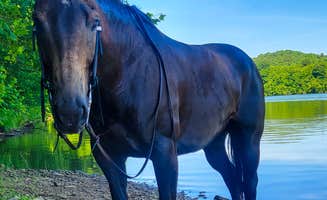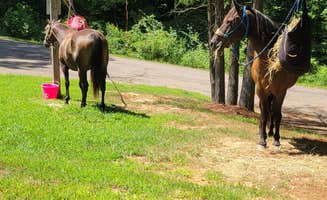Equestrian camping near Lore City, Ohio offers access to extensive trail networks in southeastern Ohio's rolling Appalachian foothills. The region contains portions of Wayne National Forest and several state parks with varied terrain at elevations between 800-1,200 feet. Trail conditions can change dramatically with seasonal rainfall, creating muddy sections in spring and drier paths during summer and fall months.
What to do
Trail riding on Paw Paw trail: The Kinderhook Horse Trail system includes trails of varying difficulty with the Paw Paw trail standing out for its quality. "The Paw Paw trail was very smooth, dry and wide. The trail leads to the top of the hill," notes Annika E. about this Kinderhook Horse Trail route.
Explore lake activities: Burr Oak State Park offers water activities for when you're not riding. "We went fishing and saw lots of butterflies. We cooked our meals on the fire, even though it was really hot," shares Nicole C. about her experience at Burr Oak State Park Campground.
Visit historic structures: Some trails lead to historic sites worth exploring. "Trails that lead along shore line to old stone house built in early days of Ohio. Caves to be explored that are easy to access," describes JH T. from Salt Fork State Park.
What campers like
Quiet atmosphere during off-peak seasons: Jefferson Lake State Park offers a peaceful experience for horse campers. "This smaller campground has a mix of equestrian sites and tent/RV sites. There are no showers, but the vault toilets were cleaned thoroughly every morning," reports Kimberly from Jefferson Lake State Park Campground.
Wildlife viewing opportunities: The parks offer chances to observe local wildlife during rides. "Just driving in saw turkeys and 'turkets':) and two 6 point bucks. You can hike, swim, boat, bike and horseback ride," shares Shelly S. about Salt Fork State Park.
Drinking water access for horses: Some facilities provide water for horses on-site. "Area is dedicated to horse trail riding. Nice clean area just off main road. Does have a small hand pump water spigot," notes Joe B. about the basic but functional setup at Kinderhook Horse Trail.
What you should know
Variable trail conditions: Trail quality varies by season and maintenance schedules. "The Kinderhook trail was overgrown. The Paw Paw trail on the other hand was very smooth, dry and wide," reports Annika E., highlighting the difference between trails even within the same system.
Camping space limitations: Some equestrian sites have limited space. "Not much area to camp. No fire rings, one picnic table. Definitely only for very small camper, car camp, or tent, small group," warns Joe B. about Kinderhook Horse Trail facilities.
Non-equestrians using horse areas: Be prepared for shared use at some campgrounds. "Very quiet campground with little to no other riders around. Only complaint would be the non equestrians staying in the equestrian area," notes Janessa S. about Blue Rock State Park Campground horse camping section.
Insect activity: Be prepared for bugs, especially in wooded areas. "A lot of insects, humid and dense deciduous forest surrounding the trailhead," warns Annika E. about conditions at Kinderhook.
Tips for camping with families
Look for sites with playground access: Some equestrian campgrounds include family-friendly amenities. "Clean water, restrooms, playground, sand volleyball and basketball court. Dump station and 18 miles of multi use trails," notes Theresa Tittle R. from Jefferson Lake State Park Campground.
Consider primitive tent sites: Salt Fork offers non-electric camping options. "Stayed here in the 'primitive' camp. You are basically staying with your neighbors in small cleared areas where you can see everything everyone else is doing," cautions Annie V., highlighting the proximity to other campers at Salt Fork.
Try covered sites for weather protection: Some parks offer sheltered camping spots. "A cool feature is a few of the sites have pavilion type covered patios that you can pitch your tent in to help stay dry during inclimate weather," shares Shelly S. about Blue Rock State Park Campground.
Tips from RVers
Select level sites carefully: RV sites vary in levelness across parks. "You need to be careful when booking, especially if you are trying to pitch a tent, as some sites are quite sloped. Our site was huge and right next to the water spigot," advises Kimberly about Jefferson Lake State Park.
Plan for limited hookups: Many equestrian campgrounds have restricted utility access. "Only 5 electric sites. Very clean pit toilets and the campground overall was well maintained. Fire pits have a nice grate to flip over and cook on," notes Kellie A. about camping at Jefferson Lake State Park Campground.
Bring water hose extensions: Water sources may be distant from parking areas. "Electric is a little far behind pad. We almost needed extension cord. All water full up towers only have those spigots that are not threaded," warns Eddie about Jefferson Lake's setup for RVs.




